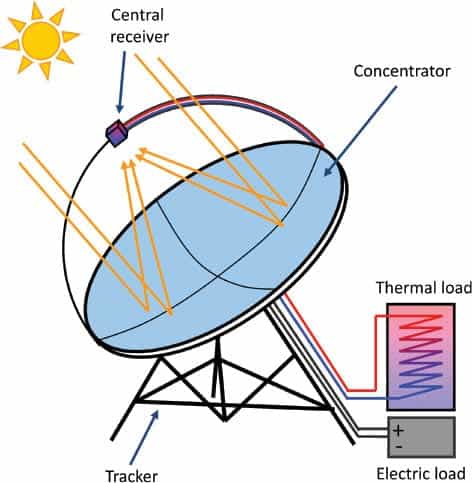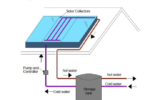Are you aware of the types of Photovoltaic cells?
Photovoltaic cells are devices which can convert sunlight to electricity directly. It only needs sunlight, not direct radiation or artificial light to generate electricity. However, the conversion efficiencies of the device depend on the types of Photovoltaic cells, the material used and the technology employed in the cells.
Types of Photovoltaic cells:
Photovoltaic cells are devices which can convert sunlight to electricity directly. It only needs sunlight, not direct radiation or artificial light to generate electricity. However, the conversion efficiencies of the device depend on the types of Photovoltaic cells, the material used and the technology employed in the cells. Mainly silicon semiconductor materials are used for the manufacture of PV cells, and technological excellence gives the particular type of Photovoltaic cells an edge over other types.
Crystalline silicon Photovoltaic cells:
Crystalline silicon Photovoltaic cells are the most popular and common types of Photovoltaic cells available in the market nowadays. Semiconductor materials like silicon are used to develop such cells. The simple technology employed in melting the silicon followed by crystallising the same into ingots. A single crystal of silicon is called monocrystalline and a block of silicon crystal is called polycrystalline. The thin slice of crystal is known as a wafer. Wafers are made polished, doped, coated, and interconnected to make cells. Photovoltaic Cells are made from both monocrystalline and polycrystalline silicon.

Monocrystalline silicon Photovoltaic cells:
Monocrystalline silicon Photovoltaic cell is considered one of the best PV Cells available in the market with 15% efficiency. Such a cell is manufactured from a single-crystal silicon body. The uniform molecular structure of the silicon wafer makes it efficient in the production of electricity. Such a device needs less space and produces more energy. Such types of Photovoltaic cells perform better in low light. It has long life however, it is very costly and may not be the first choice of the homeowner.
Polycrystalline silicon Photovoltaic cells:
Polycrystalline silicon Photovoltaic cell is often referred to as multi-crystalline Silicon PV Cell. Such a cell has considered energy efficiencies packed at 13%. Multi-crystalline Silicon PV Cell manufactured from a number of smaller groups of crystals. The making process is simple and less wasteful as compared to monocrystalline PV cells. It is less expensive, less efficient and has a lesser lifespan. More cells are required to be installed to get the desired power. Such types of Photovoltaic cells are preferred by individual house owners to get green energy.
Thin-film Photovoltaic cells:
Thin-film Photovoltaic cell is one of the low-cost cell available in the market. It is made by depositing one or more thin layers of non-crystalline silicon on a supportive material like glass, plastic or metal. The overall thickness of each cell is lower than an equivalent cut crystalline cell, providing the name of a thin-film PV cell.
The energy production efficiency is as low as 7% making it the least efficient. The biggest advantage of this cell is it can work well in low light and is cost-effective. It needs more protection for longer life and more space for required production. Thin-film Photovoltaic cell is two types.
- Cadmium Telluride(CdTe)– Such a poly-crystalline semiconductor material made from two materials such as cadmium and telluride. CdTe is the second most common PV cell material after silicon. Thin film CdTe has high light absorption capacity, hence CdTe semiconductor material requirement is very minimal even less than 1.0 microns. The manufacturing process is easy and cost-effective. However, Cadmium in such cells is a polluting agent and energy conversion efficiency is low.
- Copper indium gallium diSelenide(CIGS)– It is normally a p-type cell with optimal properties for a PV cell and higher energy conversion efficiencies of around 12%. But the manufacturing process is more complex than CdTe cells and needs more maintenance than silicon cells.
Perovskite Photovoltaic cells:
Perovskite Photovoltaic cell is one of the different types of Photovoltaic cells built with thin-crystal layers. The thin layers of materials are printed, coated or vacuum deposited on an underlying substance or layer. Such a cell is easy to manufacture and assemble having energy conversion efficiency similar to crystalline silicon. However not available in the market.

Hybrid Silicon Photovoltaic cells:
A hybrid Silicon Photovoltaic cell is one of the different types of Photovoltaic cells made by combining two or more PV Cells. Hybrid means more energy conversion efficiencies and more cost. It is made by combining Monocrystalline cells and Thin-film Photovoltaic cells. Such a cell is available in the market but more can be achieved after R&D.
Organic Photovoltaic cells:
Organic Photovoltaic cell is eco-friendly and employs second-generation technology. Such a type of cell is composed of molecular or polymeric absorbers and can enhance and achieve a specific function of the device, such as bandgap, colour etc. It can have low energy conversion efficiencies at about 11%.
Multijunction Photovoltaic cells:
Multijunction Photovoltaic cells are different types of Photovoltaic cells, that use different semiconductor materials containing many layers. Each layer has a different bandgap which empowers the cells to absorb the other parts of the solar spectrum, increasing its efficiency in comparison to single junction counterparts. Such cells have energy conversion efficiencies at a best of around 45%. However, making these cells involves a complicated process along with the involvement of more money that is reserved for space exploration.
Concentrated Photovoltaic cells:
A new technology used in referred cells for the generation of electricity from sunlight made it unique from the other types of Photovoltaic cells. However, it uses lenses or mirrors to focus sunlight on small, and efficient multifunctional solar cells. Its energy conversion efficiencies are better than its conventional counterparts. It is expensive but commercially viable even with the existing technology.

Conclusion:
Solar energy is one of the best alternative eco-friendly renewable energy sources. Research and Development in this field are continuing unabated to get the best Photovoltaic or solar cells. The different types of Photovoltaic cells available today are the fruits of R&D by different countries and institutions. Now customers can choose the best alternative cells as per their requirements and availability of funds. We may expect more energy-conversion efficient solar cells at low cost in near future.



0 Comments